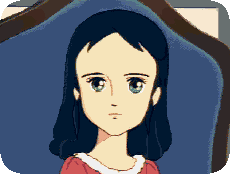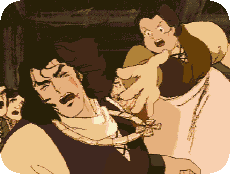Screenplay

|
"A film basically needs three things: a good screenplay, a good screenplay and a good screenplay." | |
| - Alfred Hitchcock - |

|
"A film basically needs three things: a good screenplay, a good screenplay and a good screenplay." | |
| - Alfred Hitchcock - |
To do a screen adaption of a novel is not an easy task. You can express the feelings and thoughts of the characters using facial expressions and the skill of the voice actors but the real problem is the right timing. The temporal structure of a novel can be very different from the usual straightforward structure of a film or in this case a series. In a book there can be descriptions of general facts as well as long-term developments. In a series, one thing has to happen after another (well, in most of the cases).
 Let us see how the original novel
'A Little Princess' is structured. The Frame consists of the
major events of the story. This is no problem. But now it is getting
difficult. The book is written in a relative descriptive style. This means
that the storyline is not composed just of succeeding events or actions.
Instead, there are many key scenes which are loosely connected in different
ways. For example the current situation could be related by a simple
description, or a dialogue between two pupils of the Seminary could tell the
reader about Sara's situation. Some key scenes are important for later in the
story of course.
Let us see how the original novel
'A Little Princess' is structured. The Frame consists of the
major events of the story. This is no problem. But now it is getting
difficult. The book is written in a relative descriptive style. This means
that the storyline is not composed just of succeeding events or actions.
Instead, there are many key scenes which are loosely connected in different
ways. For example the current situation could be related by a simple
description, or a dialogue between two pupils of the Seminary could tell the
reader about Sara's situation. Some key scenes are important for later in the
story of course.

| "Sara stood quietly, with her eyes fixed upon Miss
Minchin's face. She was thinking something odd, as usual." (She sat down after a while in the anime. ^_^) |
To turn this into the straightforward storyline needed for the series, the essence of the plot must be determined and embedded into suitable frames in each episode while keeping as many details from the book as possible as far as they are compatible with the layout. Some examples for those details:
As stated above, frames are necessary to embed the single parts of the story into the respective episodes. For example the chapter of the book where Sara became Lottie's adopted mother was not large enough to fill a whole episode, so some additional story was put into it: Lottie ran away and they first had to find her before Lottie could drive poor Miss Amelia to despair. This all means altering of the original story of course but that does not mean that it is bad. In fact, the story was altered (not just added to) at several places mainly for two reasons. The first reason is, that some parts of the book are not so suitable to adapt for the screen. For example I do not think that I would like to hear Sara telling her father that she feels like a soldier going into battle in the series.

Even key scenes must sometimes be altered because of this and especially because of the second reason. The character guide tells that unlike in the book, the Sara from the series does not pretend to be a princess. So the scene where she confronted Miss Minchin with that thought had to be altered. It was friendly Msr. Dufarge who compared Miss Minchin with the enraged peasant woman who has slapped King Alfred. The parts of the book dealing with the bastille and the French revolution were left out. The Sara from the series is more realistic. I was not sorry for these but I missed one particular key scene. It is tho one where Sara had a "quarrel" with Emily. I think one particular scene from the series served as a replacement, but I am not sure. In this scene Sara was very ashamed because she was taken for a beggar by a little boy. There was a close-up on Emily in this scene but that is all. It is probably very difficult to adapt this special scene for the screen. I have once seen an attempt in another Sara-version (with Amelia Shankley) and I must say it was pretty pathetic.

| "She quite made Lottie see them, too. Lottie could always believe in the things Sara made pictures of." |
Now we have got indeed a good script which tells the story in a straightforward manner without neglecting the daily life at the Seminary and which is still faithful to the original novel. But it would be better if we actually had a very good script. The book mainly focused on just a few characters, in most of the cases Sara, Miss Minchin and Ermengarde. Almost the whole story takes place inside the Seminary and is therefore very much like a play (which it actually was before the novel was written). For films or series a big chance opens up. The Seminary is located in London and many people live in London. 'A Little Princess Sara' uses the chance to fill the story with life. It introduces some new characters which are either only mentioned in the novel or completely new although they are always connected in a way with the original story. The additional characters are so well involved in the story that a great deal of charm is added to the series. Here the most important of them:

With this very good script, we can be content.
Hm, or what about an excellent script? Ok.
Several steps have been taken to improve the dramaturgy. In the novel, the
dissolved party on the attic was placed directly before the beginning of the
Magic to set up a contrast. It is like seeing the sunlight at the end of the
tunnel. This technique is very useful as you may expect and it was used in the
series in a very effective way. The party was placed just before the incident
with the 4 penny piece (guess why) and was replaced by a 2 episodes long tale
of terror which I cannot relate here because I do not want to scare you off.
But just wait until the Magic begins. You will never forget it!

| "Alfred the Great, for instance, burning the cakes and getting his ears boxed by the wife of the neatherd. How frightened she must have been when she found out what she had done." |
I now want to show you something that I would call a true masterpiece of story-telling. In the original novel, Miss Minchin demanded from Sara that she must be grateful for Miss Minchin's kindness just after her father's death. Sara's answer quite irritated Miss Minchin. In the series, she was yet too timid and Miss Minchin quite took her by surprise. Instead, Saras answer was placed on a particular episode at almost the end of the series. In the earlier episodes tension was constantly increasing just to discharge all at once. But it was indeed a very bad time for Miss Minchin to get that angry at Sara. It was actually the time when finally Sara got fed up with her.
Do not worry if you are new to the story and have not understand everything on this page. It will all become clear if you either read the book or watch the series.